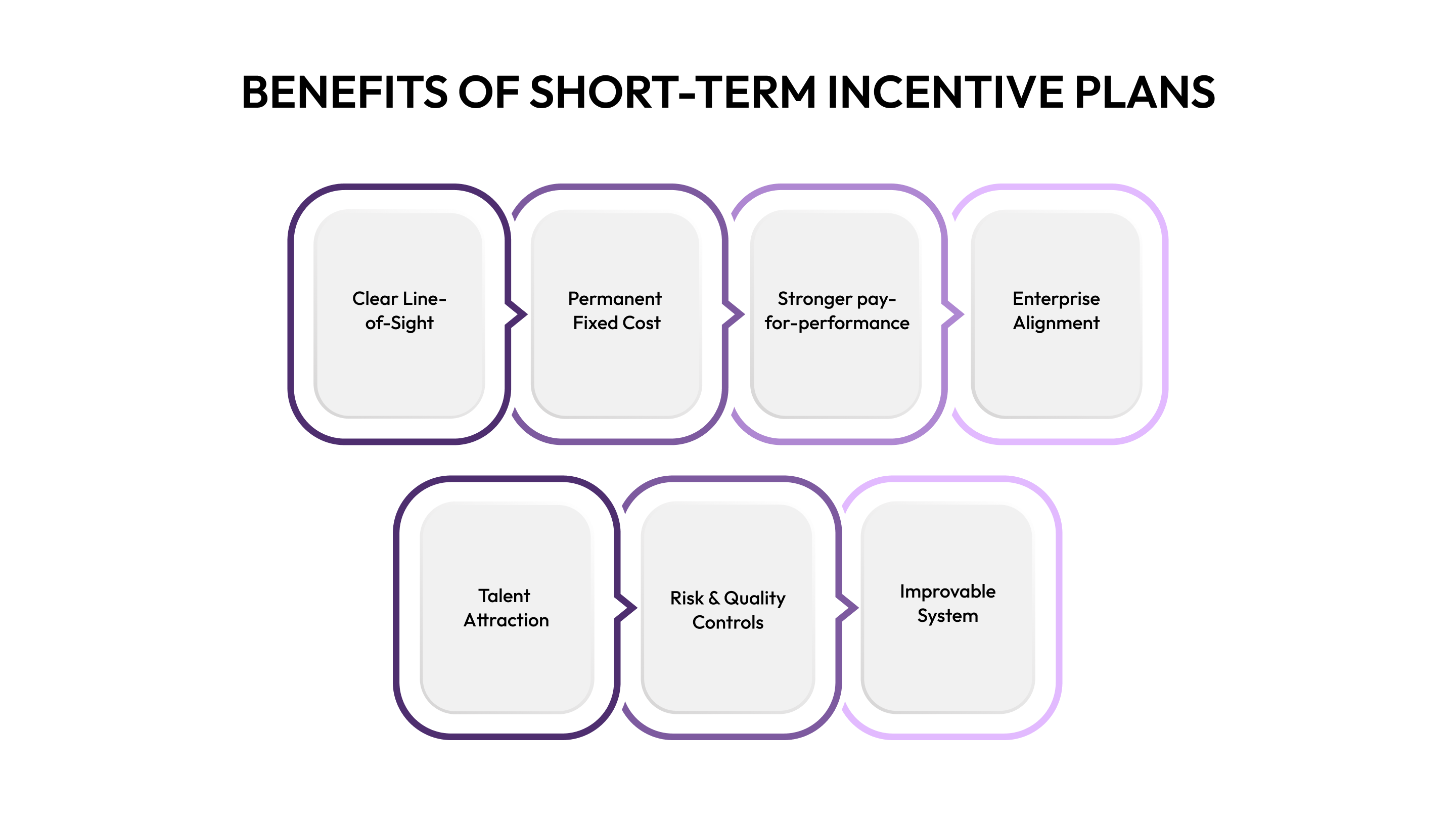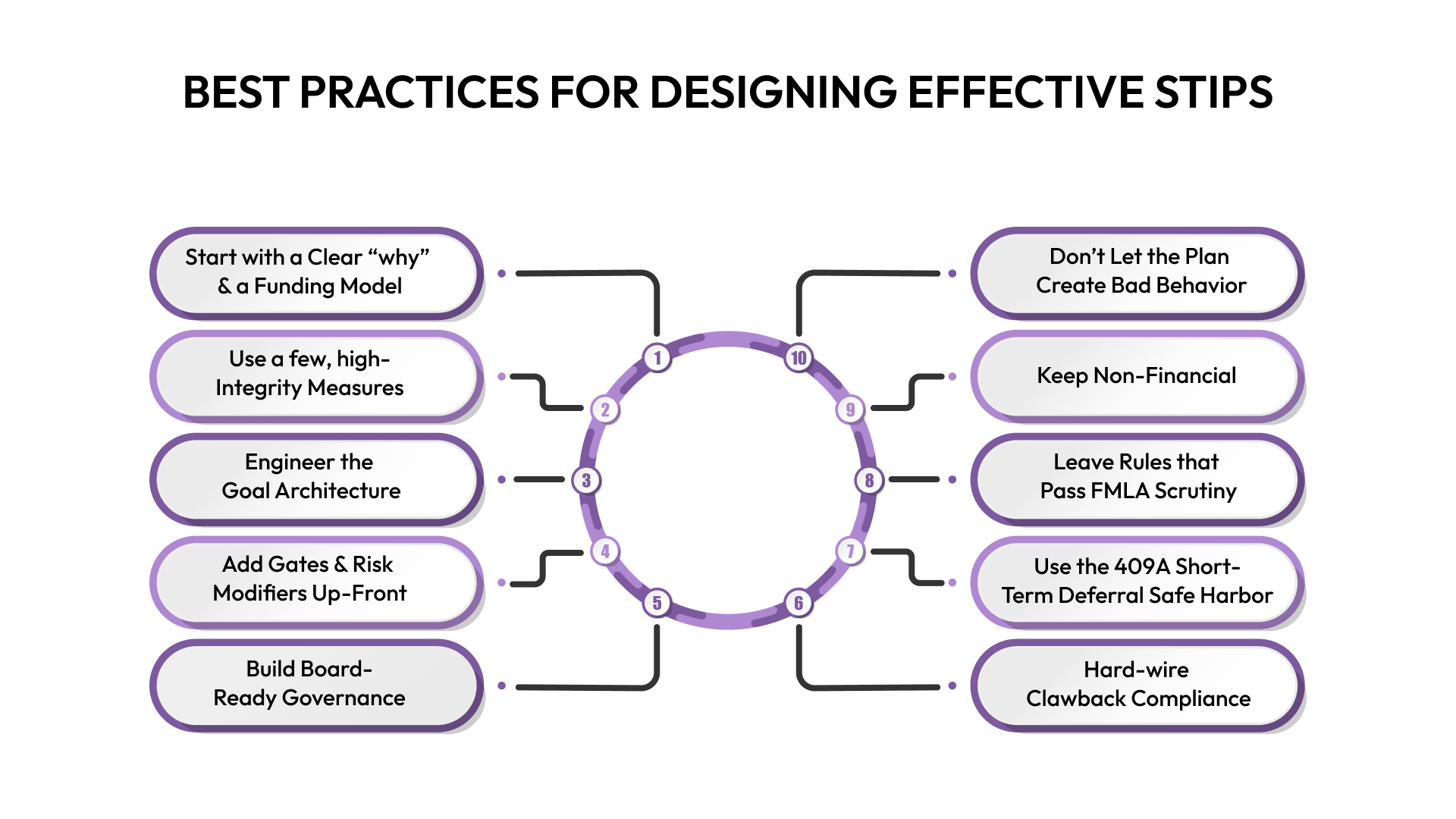Short Term Incentive Plan Components and Benefits
Explore short term incentive plan examples. Discover cash bonuses and vesting schedules to boost performance. Click to learn more!

Companies need to find ways to motivate and retain top talent, and one of the most effective tools in doing so is the Short-Term Incentive Plan (STIP). In 2024, nearly 64% of companies reported paying out below target on their STIPs, leading to an average payout of 89% of the target amount. This statistic underscores the critical role STIPs play in motivating employees and achieving organizational goals.
So why are STIPs so important? They take the guesswork out of compensation by tying financial rewards directly to individual or team achievements. It's simple: when employees know their hard work will be rewarded in a meaningful way, they’re more likely to go above and beyond.
In this blog, we’re going to break down the key components of an effective STIP, share examples from real-world scenarios, and get into the benefits these plans bring to both employers and employees.
Key Takeaways
- Short-term incentive plans (STIPs) are designed to reward employees based on measurable performance outcomes, typically within a one-year period.
- STIPs align employee goals with organizational objectives, creating a performance-driven culture that benefits both employees and employers.
- These plans are structured around clear metrics, thresholds, and payout formulas, ensuring transparency and fairness in how rewards are distributed.
- STIPs offer a flexible, cost-effective way for companies to motivate employees while adapting to changing business priorities.
- Properly implemented STIPs provide immediate recognition, helping to increase employee engagement, retention, and overall job satisfaction.
What is a Short-Term Incentive Plan?

A Short-Term Incentive Plan (STIP) is a variable-pay program that rewards employees for achieving performance goals over a period of one year or less, often paid quarterly or annually. Properly designed, STIPs tie near-term business priorities (for example, revenue, margin, safety, CX, or project milestones) to cash awards using preset measures, targets, and payout formulas.
The primary purpose of a short-term incentive plan is to align individual, team, and organizational objectives. By linking rewards to measurable outcomes, such as sales targets, project completion, or operational efficiency, STIPs encourage employees to focus on the actions that directly impact the company’s short-term success.
- Defined performance period: Typically measured quarterly or annually, ensuring rewards are closely tied to recent results.
- Objective performance metrics: Goals are quantifiable and role-specific, such as revenue growth, efficiency gains, or customer satisfaction.
- Transparent payout structure: Employees know the thresholds, targets, and caps that determine their bonus or incentive payout.
- Eligibility criteria: Participation is determined by role, level, or contribution, making the plan relevant to those who directly impact business outcomes.
- Flexibility for business priorities: Plans can be adjusted year to year to reflect shifting company objectives, ensuring alignment with current strategy.
- Immediate recognition: Rewards are delivered soon after performance is measured, reinforcing motivation and accountability.
A STIP bridges day-to-day execution with business outcomes by turning measurable performance into tangible rewards. They serve as a motivational tool that not only drives performance but also ensures employees understand how their contributions directly influence company success.
Suggested read: Top Employee Incentive Ideas to Boost Engagement

Understanding what a short-term incentive plan is lays the groundwork for exploring its core components, which define how these plans operate in real-world organizations.
Core Components of a Short-Term Incentive Plan
A well-designed short-term incentive plan (STIP) balances clarity, fairness, and strategic alignment. By defining its key components upfront, organizations ensure that employees understand how performance translates into rewards, while leaders can confidently manage costs and expectations.
- Plan purpose and alignment: Define the plan’s intent (e.g., growth, profitability, cash conservation) and which outcomes matter most this cycle. This “why” anchors the rest of the design and keeps goals connected to strategy.
- Eligibility and participation rules: State who’s in (by level/job family/business unit), when eligibility begins, and what happens for mid-year hires or transfers. Many advisors treat eligibility and funding as first-order design decisions because they shape both motivation and cost.
- Performance measures and weights: Select a small set of measures with clear line-of-sight (e.g., Operating Income, Revenue, Cash Flow, EPS, plus role-specific KPIs). Market practice shows earnings and revenue measures dominate annual plans, often paired with operational or individual goals.
- Goal-setting framework (threshold/target/maximum): Document how goals translate to pay. Typical market patterns: threshold around or below 50% of target payout, and maximum around 200% of target (varies by company and metric).
- Payout curve (the “shape” of pay vs. performance): Spell out linear vs. non-linear curves, interpolation, and where the slope steepens. Benchmarks frequently show max opportunities clustered at ~200% of the target.
- Funding model and affordability guardrails: Explain how the plan is funded (e.g., formulaic pool tied to company results) and any affordability checks before paying individual awards. Consulting guidance treats “funding mechanisms” as a core design element alongside eligibility and formulas.
- Enterprise “gates” and modifiers: Set any gates (e.g., safety, compliance, minimum profit) that must be met before payouts flow, plus allowable up/down modifiers to reflect risk, quality, or extraordinary items. Governance and risk articles highlight the need to adjust incentives when risk or conduct issues surface.
- Individual performance component: Define how much of the bonus is influenced by individual goals or a personal performance modifier (and the range, e.g., 0.8×–1.2×). Prevalence data shows companies commonly include individual goals or modifiers in annual plans.
- ESG/DEI and customer metrics (where relevant): If using non-financial measures (e.g., safety, customer satisfaction, talent/DEI), document weights, data sources, and auditability. Short-term plans increasingly incorporate these factors, though practices vary by industry.
- Performance period, timing, and frequency: State the performance window (annual/quarterly/project-based), the evaluation timeline, and payment dates. This is a foundational plan for plumbing alongside core processes such as metrics and payout formulas.
- Proration and leave/term rules: Define how awards are prorated for mid-year hires, promotions, leaves of absence, and terminations (with attention to FMLA parity for goal-based bonuses in the U.S.).
- Governance and discretion: Clarify who owns the plan (Comp Committee/Executives), what discretion is allowed, and how exceptions are documented. Sales and incentive governance frameworks call out governance as a distinct design pillar.
- Clawback / malus and compliance language: Include recoupment provisions consistent with regulation and listing standards (e.g., SEC clawback rules for U.S. public companies) and any broader company policies on recovering incentive pay after restatements or misconduct.
- Administration and technology: Note the systems used for eligibility, calculations, approvals, and audit trails. Research links better outcomes to moving beyond spreadsheets for administering base pay and short-term incentives.
- Communication plan and manager enablement: Plan the communications cadence (launch, mid-year check-ins, year-end statements) and equip managers with FAQs and talking points. HR guidance points to communication quality as a major driver of plan credibility.
With these foundational components defined, organizations can now explore practical short-term incentive plan examples to see how STIPs are applied across different roles and industries.
Short-Term Incentive Plan Examples

Short-term incentive plans (STIPs) come in many forms, reflecting the variety of roles, goals, and organizational priorities. Seeing practical examples helps illustrate how the components discussed earlier are applied in real-world scenarios.
1) Sales-Driven STIP
A sales team STIP typically ties compensation directly to revenue, bookings, or margin targets.
Structure:
- Base pay plus a variable bonus.
- Performance metrics: quarterly sales revenue, new client acquisition, or account retention.
- Payouts: threshold (50% of target) to maximum (150–200% of target) with individual modifiers based on territory performance.
Purpose: Motivates sales teams to exceed quotas while rewarding top performers transparently.
2) Operational Performance STIP
For operations or production teams, incentives focus on efficiency, quality, or cost-control measures.
Structure:
- Team bonus pool allocated quarterly.
- Performance metrics: production output, defect reduction, on-time delivery, or process efficiency.
- Payouts: proportionate to achievement against agreed thresholds; capped to control budget impact.
Purpose: Encourages operational excellence and collaboration, aligning team outcomes with company efficiency goals.
3) Individual KPI-Based STIP
Knowledge workers or technical roles may have individualized STIPs based on measurable contributions.
Structure:
- Individual bonus based on annual performance review and role-specific KPIs.
- Metrics: project completion, innovation contributions, client satisfaction, or skill acquisition.
- Payouts: tied to achievement against pre-defined thresholds with transparency in calculation.
Purpose: Rewards high-performing individuals, aligning efforts with both team and organizational priorities.
4) Team-Based STIP
Cross-functional or project teams may have pooled incentives to encourage collaboration and shared accountability.
Structure:
- Shared bonus pool distributed based on collective achievement.
- Performance metrics: project milestones, launch success, or cross-department KPIs.
- Payouts: scaled by team success, with mechanisms for fair individual adjustments where contributions vary.
Purpose: Promotes teamwork and ensures rewards are tied to collective success rather than only individual outcomes.
5) Combined STIP Approach
Many organizations blend multiple STIP types to address different business needs simultaneously.
Structure:
- Base salary + individual STIP + team STIP + strategic bonus (optional).
- Metrics include a combination of revenue, operational, and strategic project KPIs.
- Payouts are layered to ensure alignment at multiple levels—individual, team, and company.
Purpose: Balances individual accountability with team performance and organizational priorities, creating a holistic incentive ecosystem.
With these examples in mind, the next step is understanding the benefits of short-term incentive plans for both employees and employers, highlighting why STIPs are a critical part of total rewards strategy.
Benefits of Short-Term Incentive Plans

Short-term incentive plans (STIPs) are strategic tools that drive performance, align employee efforts with organizational goals, and foster a culture of accountability and engagement. When designed thoughtfully, STIPs offer a multitude of benefits for both employees and employers:
- Clear line-of-sight to what matters now: STIPs focus attention on near-term priorities (revenue, margin, quality, customer outcomes) and create a direct connection between day-to-day work and payout. Research ties well-designed financial incentives to improved performance when goals and measurements are clear.
- Budget flexibility without permanent fixed cost: Variable pay lets companies reward outperformance in good years and dial back spend when conditions tighten—something salary budgets can’t do. Market reports show variable pay (bonuses, annual incentives) remains a central tool alongside merit increases in 2024–2025 planning.
- Stronger pay-for-performance credibility: When the payout curve, gates, and metrics are published up front, employees see a fair system rather than discretionary bonuses. WorldatWork and HBR reporting show short-term bonuses are near-universal, underscoring the importance of getting design and governance right.
- Enterprise alignment across functions: Blending company, team, and individual measures avoids siloed effort. High-performing organizations that systematize performance management link incentives to a few critical outcomes and outperform peers on growth and retention.
- Talent attraction and retention signal: Candidates increasingly ask how performance is rewarded. A transparent STIP with posted ranges and clear criteria signals fairness and can differentiate your offer without structurally inflating base pay.
- Risk and quality controls built in: Gates (e.g., safety, compliance) and audited metrics let companies pay for healthy performance, not just volume. SHRM’s analyzes of incentive risks highlight the need for documentation, audit trails, and course correction when metrics create unintended behaviors.
- Measurable, improvable system: Because STIPs run on a defined cadence, HR and Finance can A/B test metrics, calibrate payout curves, and learn each cycle—tightening the link between incentives and business outcomes over time. WorldatWork’s ongoing incentive research reinforces this “learn and adjust” operating model.

Best Practices for Designing Effective STIPs

High-performing short-term incentive plans are built with the same rigor you’d apply to a budget or product roadmap. Here are practitioner-level techniques that go beyond basics and keep payouts aligned with value creation, compliance, and risk:
- Start with a clear “why” and a funding model: Anchor the plan to this year’s priorities (e.g., cash, margin, growth) and document how the pool is funded—formulaic funding tied to company results, plus affordability checks before awards are released. Treat funding mechanics as a first-order design choice, not a footnote.
- Use a few, high-integrity measures with line-of-sight: Select 2–4 metrics people can actually influence (e.g., Operating Income, Revenue, Cash Flow, key operational KPIs). Weight them explicitly and avoid vanity indicators. This mirrors current market practice and improves plan credibility.
- Engineer the goal architecture (Threshold/Target/Max): Make the math transparent: define threshold, target, and maximum performance with a documented payout curve. Calibrate probabilities so most years land around the target, outperformance earns into the top bucket, and true misses land below the threshold.
- Add gates and risk modifiers up-front: Introduce non-negotiables (e.g., safety, minimum profit) that must be met before payouts flow, and allow downward modifiers where risk, conduct, or quality issues emerge. Global and U.S. regulatory guidance underscores the importance of risk-sensitive incentives.
- Build board-ready governance and discretion: Spell out who owns goal approval, how exceptions are handled, and when negative discretion applies. Compensation committee resources and governance frameworks expect an explicit oversight model for incentives.
- Hard-wire clawback compliance: For public companies, incorporate an SEC Rule 10D-1–compliant clawback covering incentive pay tied to financial reporting measures, and be prepared to disclose policy and recoveries under exchange listing standards.
- Use the 409A short-term deferral safe harbor: Design cash bonuses to be paid within 2½ months after the close of the performance year (e.g., by March 15 for calendar-year companies) to stay outside Section 409A. Document timing and avoid provisions that inadvertently create deferred compensation.
- Write proration and leave rules that pass FMLA scrutiny: State exactly how mid-year hires, promotions, leaves, and terminations are handled. For goal-based bonuses, FMLA rules allow denial only if you treat employees on equivalent non-FMLA leave the same way—so codify parity and keep records.
- Keep non-financial/ESG metrics auditable: If you include safety, customer, or talent/DEI goals, define the data source, measurement period, and assurance process. Investors increasingly expect rigor, not vague narratives.
- Don’t let the plan create bad behavior: Test for gaming and unintended consequences, normalize for one-offs where appropriate, cap windfalls, and include quality gates. HR research shows poorly designed incentives can undermine ethics and teamwork.
Also read: How to Create an Effective Employee Incentive Plan
Conclusion
When designed well, Short-Term Incentive Plans can become a powerful lever for motivating employees, driving performance, and aligning their contributions with the company’s strategic objectives. Beyond just offering financial rewards, STIPs create clarity, encourage accountability, and ensure that top performers are recognized and rewarded.
By integrating effective STIPs into your compensation strategy, you’re not only building a motivated workforce but also establishing the foundations for sustained business growth and success.
At CandorIQ, we provide a comprehensive platform that helps you design and manage equitable, performance-driven compensation strategies, ensuring that every incentive aligns with your broader organizational goals. With CandorIQ, you can take your compensation management to the next level, making data-driven decisions and improving the fairness and effectiveness of your incentive programs.
If you’re ready to turn your short-term incentives into long-term success, book a demo with CandorIQ today and see how our platform can help you build a smarter, more effective incentive program.
FAQs
1. How can STIPs help businesses during uncertain times?
STIPs offer flexibility in budget allocation, as they are tied to company performance, allowing organizations to adjust payouts based on profitability and market conditions.
2. What are the best performance metrics to include in a STIP?
The best metrics are those directly tied to business goals, such as revenue, profitability, customer satisfaction, and operational efficiency, which can be easily measured and influenced by employees.
3. How do you ensure fairness in a STIP?
Ensure transparency in goals, targets, and payout structures. Regular audits and objective performance criteria prevent favoritism and ensure all employees have equal opportunities to earn incentives.
4. Can STIPs be applied to non-sales roles?
Yes, STIPs are not limited to sales teams. Roles across departments can have performance-based incentives tied to specific KPIs like project completion, cost reductions, or team collaboration.
5. How often should an organization review its STIP?
STIPs should be reviewed annually or at key milestones to ensure alignment with shifting business objectives, market trends, and employee feedback, making adjustments as necessary to maintain motivation and fairness.


